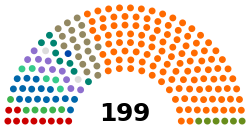Top Qs
Timeline
Chat
Perspective
National Assembly (Hungary)
Unicameral legislature of Hungary From Wikipedia, the free encyclopedia
Remove ads
The National Assembly (Hungarian: Országgyűlés, lit. 'Country Assembly' [ˈorsaːɡɟyːleːʃ]) is the parliament of Hungary. The unicameral body consists of 199 (386 between 1990 and 2014) members elected to four-year terms. Election of members is done using a semi-proportional representation: a mixed-member majoritarian representation with partial compensation via transfer votes and mixed single vote; involving single-member districts and one list vote; parties must win at least 5% of the popular vote in order to gain list seats. The Assembly includes 25 standing committees to debate and report on introduced bills and to supervise the activities of the ministers. The Constitutional Court of Hungary has the right to challenge legislation on the grounds of constitutionality.

Under communist rule, the National Assembly existed as the supreme organ of state power as the sole branch of government in Hungary, and per the principle of unified power, all state organs were subservient to it. Since 1902, the assembly has met in the Hungarian Parliament Building in Budapest.
The current members are the members of the National Assembly of Hungary (2022–2026).
Remove ads
History
Summarize
Perspective
The Diet of Hungary[1] (Hungarian: Országgyűlés) was a legislative institution in the medieval kingdom of Hungary from the 1290s,[2] and in its successor states, Royal Hungary and the Habsburg kingdom of Hungary throughout the Early Modern period. The name of the legislative body was originally "Parlamentum" during the Middle Ages, the "Diet" expression gained mostly in the Early Modern period.[3] It convened at regular intervals with interruptions during the period of 1527 to 1918, and again until 1946.
In 1608, a bicameral legislature was enacted as the Royal Hungarian Diet, dividing the main board and the lower board (the board of envoys). Members of the main board (the upper house) were the high nobles and high priests (archbishops and bishops). The lower board was attended by representatives of the common nobility, clergy and civil order: elected representatives of the noble county, delegates of the free royal cities and representatives of the lower Church representatives.[4]
Approximately 10% of the total voting age population could vote for the elected delegates of the lower board (5% county nobility, 5% residents of free royal cities). The election of the noble delegates (1 delegate from each county) took place in the county delegate elections, after a long, noisy, courtier campaign, at the county hall. Delegates had issues from county assemblies about voting in exact things.
The parliament consisted of about 500 people in the 17th–18th centuries.
The articles of the 1790 diet set out that the diet should meet at least once every 3 years, but, since the diet was called by the Habsburg monarchy, this promise was not kept on several occasions thereafter. As a result of the Austro-Hungarian Compromise, it was reconstituted in 1867.
The Latin term Natio Hungarica ("Hungarian nation") was used to designate the political elite which had participation in the diet, consisting of the nobility, the Catholic clergy, and a few enfranchised burghers,[5][6] regardless of language or ethnicity.[7] Natio Hungarica was a geographic, institutional and juridico-political category.[8]
The democratic character of the Hungarian parliament was reestablished with the fall of the Iron Curtain and the end of the communist dictatorship in 1989. Today's parliament is still called the Országgyűlés, as in royal times, but is called the 'National Assembly' to distance itself from the historical royal diet.
Latest general election
Result by constituency
Party list results by county and in the diaspora

Fidesz: 40–50% 50–60% 60–70%
United for Hungary: 40–50%
Remove ads
Speakers of the National Assembly of Hungary
Historical composition of the National Assembly since 1990
| ||||||||||||||||||||
| 1990[e] |
| |||||||||||||||||||
| 1994 |
| |||||||||||||||||||
| 1998 |
| |||||||||||||||||||
| 2002 |
| |||||||||||||||||||
| 2006 |
| |||||||||||||||||||
| 2010 |
| |||||||||||||||||||
| 2014[f] |
| |||||||||||||||||||
| 2018 |
| |||||||||||||||||||
| 2022 |
| |||||||||||||||||||
Remove ads
Notes
References
External links
Wikiwand - on
Seamless Wikipedia browsing. On steroids.
Remove ads




